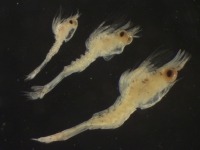
(Photo: Huntsman Marine Science Centre)
Sand Shrimp
Crangon septemspinosa
Transparent shrimp. Grey or brown speckled colouring makes them look like they are sandcovered. They have long antennae, and dark-colored uropods (part of their tail). The sand shrimp has one pair of claws shaped like hooks, and a large dorsal spine on their fifth abdominal segment. They grow up to seven centimetres in length.
Authority
Say, 1818
Classification Details
Phylum: Arthropoda (arthropods); Subphylum: Crustacea (crustaceans); Order: Decopoda (decapod crustaceans).
Habitat
Found from the northern Gulf of St. Lawrence to east Florida, in seaweeds and along sandy bottoms. In the summer, sand shrimp dwell in shallow waters, particularly in estuaries. In winter they move to deeper waters. They burrow in the sand during the day and are active at night.
Diet
Forages at night among the benthic community (on the seabed). Consumes invertebrates, dead material, and larval fish. Occasionally, they may engage in cannibalism (eating other sand shrimp).
Reproduction
Separate sexes. The male fertilizes the female's eggs. She holds them in the hairs of her abdominal legs for several weeks before they hatch into planktonic larvae. The zoea larval stage resembles the adult form. They have feeding and swimming legs. The larval phase lasts 32 to 46 days. The zoea molt five to seven times to become larger and more developed, before metamorphosing into an adult. Adults can live three to four years.
Fun Facts
Larval release from the eggs is triggered by high phytoplankton levels in the seawater. This ensures there is plenty of phytoplankton for the larvae to eat after hatching.
During the day, sand shrimp are found buried in the seabed with only their antennae exposed.
References
Campos J, Moreira C, Freitas F and van der Veer HW (2012) Short review of the eco-geography of Crangon. Journal of Crustacean Biology 32, 159–169. Johnson WS and Allen DM (2005) Zooplankton of the Atlantic and Gulf Coasts. Maryland: Johns Hopkins University Press. Massie FD (1998) Sand shrimp. In: The Uncommon Guide to common life on Narragansett Bay. Available at http://www.edc.uri.edu/restoration/html/gallery/invert/sand.htm Accessed online 20 January 2020. Reebs SG, Jackman PM, Locke A, and Fairchild WL (2011) Avoidance by sand shrimp, Crangon septemspinosa, of sandy patches covered by hydrated lime (calcium hydroxide) deposits. Canadian Technical Report of Fisheries and Aquatic Sciences, no. 2938, 7pp. Tesmer CA and Broad AC (1964) The larval development of Crangon septemspinosa (Say). The Ohio Journal of Science 64, 239–250. Van Guelpen L, Pohle G, Vanden Berghe E and Costello MJ (2005) Marine Species Registers for the North Atlantic Ocean. World Wide Web electronic publication. http://www.vliz.be/vmdcdata/narms/ Wehrtmann IS (1990) Larval production of Crangon septemspinosa in waters adjacent to Chesapeake Bay, USA, in relation to oceanographic conditions. International Council for the Exploration of the Sea. Shellfish Committee, no. IIC–9, 12pp. Wehrtmann IS and Stagg C (1990) Distribution of Crangon septemspinosa larvae off Chesapeake Bay, USA : a comparison of field data and the results of a larval transport model. International Council for the Exploration of the Sea. Shellfish Committee, no. IIC–9, 5pp World Register of Marine Species. Crangon septemspinosa Say, 1818 – WoRMS Taxon Details. http://marinespecies.org/aphia.php?p=taxdetails&id=158355 Accessed online 20 January 2020.

